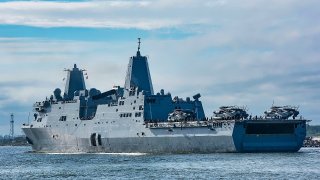The Navy Has a Warship That Could be Way Better Than Aircraft Carriers
The U.S. Navy’s San Antonio-class amphibious transport docks (LPDs) represent a versatile and cost-effective solution for future naval power projection, as opposed to the very expensive aircraft carriers of today, like the Ford-class, which cost $120 billion.
Key Points You Need to Know Now: The U.S. Navy’s San Antonio-class amphibious transport docks (LPDs) represent a versatile and cost-effective solution for future naval power projection, as opposed to the very expensive aircraft carriers of today, like the Ford-class, which cost $120 billion.
-Capable of carrying up to 633 Marines, advanced vehicles, helicopters, and landing craft, these warships can execute a wide range of missions.
-Recently, the Navy commissioned the USS Richard M. McCool Jr. (LPD-29), honoring Medal of Honor recipient Capt. McCool. LPD-29 is the final Flight I variant of the San Antonio class, with 13 more advanced Flight II ships planned.
-The LPDs serve as sovereign sea bases, vital to the Navy-Marine Corps team in modern amphibious and expeditionary warfare.
Why the U.S. Navy Is Betting on San Antonio-Class LPDs for Future Conflicts
The U.S. Navy's nuclear-powered supercarriers are impressive warships able to project power around the globe. The problem is that the sea service doesn't have enough of them. They cost a lot of time and money to build, and massive crews are required to operate them.
The future could see smaller, more easily replaceable vessels that can still project considerable power around the globe. The Navy already operates such a warship – the San Antonio-class amphibious transport dock, also known as a landing platform dock (LPD).
Each LPD is 684 feet long and 105 feet wide and can carry a landing force of 66 officers and 633 Marines.
According to the Navy, LPDs can "embark, transport, and land elements of a landing force for a variety of expeditionary warfare missions. They provide the Navy and Marine Corps with modern, sea-based platforms that are networked, survivable, and built to operate in the 21st century, with the MV-22 Osprey, the upgraded Amphibious Assault Vehicle, and future means by which Marines are delivered ashore."
The warships aren't battleships by any account, but they are armed with two 30 mm Bushmaster II cannons for surface defense, along with a pair of Rolling Airframe Missile launchers for air defense. LPDs can carry four CH-46 Sea Knight helicopters, two Landing Craft Air Cushions, one Landing Craft Utility, and 14 Assault Amphibious Vehicles.
The Newest LPD Has Arrived
A few weeks ago, the Navy commissioned USS Richard M. McCool Jr. (LPD-29) at a ceremony at Naval Air Station Pensacola. The warship was named to honor "U.S. Navy Capt. Richard M. McCool, Jr., Ret. who received the Medal of Honor in 1945 for the heroism he displayed after his ship, USS LSC 122, was attacked by kamikaze aircraft in the Battle of Okinawa."
LPD-29 is the first vessel named to honor Capt. McCool, and the 13th San Antonio-class LPD commissioned in the Navy. While a dozen were originally proposed, the sea service announced in 2018 that it would increase the size of the LPD fleet. USS Richard M. McCool Jr. is the final Flight I San Antonio-class vessel, while an additional 13 Flight II variants could be produced. Construction is underway on the first three.
During the commissioning ceremony for LPD-29, Navy leaders emphasized the importance of the vessels, which have been described as "sovereign sea bases from which Marines can carry out a wide variety of missions."

"LPD 29 represents a shift in what an amphibious warship is," said Gen. C.J. Mahoney, assistant commandant of the Marine Corps. "With the latest in integrated SPY-6 (air and missile defense radar system) and Next Generation Surface Search Technology, she enables reconnaissance and counter reconnaissance on the forward edge of the battlespace – making sense and decision space for the Fleet and Joint Force Commanders."
Chief of Naval Operations Adm. Lisa Franchetti further reflected on the importance of the Navy-Marine Corps team and the San Antonio-class LPDs.
"The LPD plays an essential role on our Blue-Green team as the workhorse of our Amphibious Fleet, and soon McCool will set sail and begin embarking, transporting, and landing elements of our Navy-Marine Corps team," said Franchetti. "The commissioning of this warship puts another player with more capability on the field in America's Warfighting Navy, providing more options to our Nation’s leaders to deter and if necessary, fight and win our Nation’s wars in this decade and beyond."
Author Experience and Expertise: Peter Suciu
Peter Suciu is a Michigan-based writer. He has contributed to more than four dozen magazines, newspapers, and websites with over 3,200 published pieces over a twenty-year career in journalism. He regularly writes about military hardware, firearms history, cybersecurity, politics, and international affairs. Peter is also a Contributing Writer for Forbes and Clearance Jobs. You can follow him on Twitter: @PeterSuciu. You can email the author: [email protected].
Image Credit: Creative Commons and/or Shutterstock.


